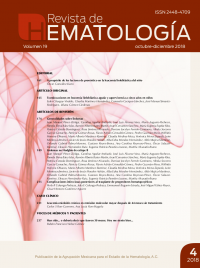B lineage non Hodgkin lymphomas.
Rev Hematol Mex. 2018 octubre-diciembre;19(4):189-214.
Juan Manuel Pérez-Zúñiga,1 Carolina Aguilar-Andrade,2 José Luis Álvarez-Vera,2 María Augusto-Pacheco,2 Pamela Elena Báez-Islas,2 Ramón Alberto Bates-Martín,2 Israel Cervantes-Sánchez,2 María Eugenia Espitia-Ríos,2 Patricia Estrada-Domínguez,2 Rosa Jiménez-Alvarado,2 Denisse Jocelyn Fermín-Caminero,2 Alinka Socorro García-Camacho,2 Patricia Gómez-Rosas,2 Flavio Adrián Grimaldo-Gómez,3 Pedro Guzmán-Mera,2 Wilfrido Herrera-Olivares,4 Mario Alberto Martínez-Ramírez,5 Claudia Medina-Meza,6Verónica Mena-Zepeda,2 Leire Montoya-Jiménez,2 Javier de Jesús Morales-Adrián,7 Alba Edna Morales-Hernández,8 Aldo Mujica-Martínez,2 Orlando Gabriel Palma-Moreno,9 Gustavo Reyes-Brena,10 Ana Carolina Reynoso-Pérez,2 Óscar Salazar-Ramírez,11Eleazar Hernández-Ruiz,12 Eugenia Patricia Paredes-Lozano,13 Martha Alvarado-Ibarra2
1 Hospital Regional General Ignacio Zaragoza, ISSSTE, Ciudad de México.
2 Centro Médico Nacional 20 de Noviembre, ISSSTE, Ciudad de México.
3 Instituto Nacional de Cardiología, Ciudad de México.
4 Hospital Regional Puebla, Puebla, México.
5 Hospital Regional de Alta Especialidad, Veracruz, Veracruz, México.
6 Hospital H+, Querétaro, México.
7 Hospital Regional ISSSTE, Mérida, Yucatán, México.
8 Hospital Ángeles Clínica Londres, Ciudad de México.
9 Hospital General de Especialidades Dr. Javier Buenfil Osorio, Campeche, México.
10 Hospital del ISSSTE de León, Guanajuato, México.
11 Hospital General Dr. Dario Fernández Fierro, ISSSTE, Ciudad de México.
12 Hospital Presidente Juárez, ISSSTE, Oaxaca, Oaxaca, México.
13 Hospital Regional 1° de Octubre, ISSSTE, Ciudad de México.
Resumen
El conocimiento de la ontogenia de los linfomas no Hodgkin ha permitido precisar y separar los grupos específicos de linfoma no Hodgkin en cuanto a estirpe, localización, características clínicas, genéticas y moleculares, entre otras. Sin duda, la aproximación a la estirpe ha contribuido a mejorar las tasas de respuesta y la supervivencia, discriminando variedades histológicas específicas, que además norman la conducta terapéutica basada en su evolución natural, definiendo así diferentes modalidades de tratamiento con resultados que buscan diversos objetivos, entre los más conocidos destacan la supervivencia libre de enfermedad, tiempo libre a nuevo tratamiento o incremento en la supervivencia global. Es indispensable utilizar diferentes herramientas, desde la historia natural, sitios de manifestación, características histológicas, marcadores de inmunohistoquímica, protocolos de diagnóstico con estos marcadores que favorezcan la reproducibilidad y aproximación diagnóstica de mayor precisión. Asimismo, el discernimiento de los diferentes subgrupos más frecuentes de linfomas no Hodgkin estirpe B favorece la optimización de los resultados al diagnosticar y tratar con una mayor precisión. En este documento se tratan los linfomas no Hodgkin de estirpe B que consideramos más frecuentes en nuestro grupo, entre los que se encuentran los linfomas difusos de células grandes, foliculares, de linfocitos pequeños, zona marginal, manto, MALT y tipo Burkitt. Finalmente diversas variedades pueden manifestarse de forma primaria en distintas localizaciones, destacan las gástricas y del sistema nervioso central que obligan a establecer tratamientos precisos en estos sitios de manifestación del linfoma no Hodgkin.
PALABRAS CLAVE: Linfoma no Hodgkin; linfoma difuso de células grandes.
Abstract
The knowledge about the ontogeny of non-Hodgkin’s lymphomas has allowed to specify and separate some groups of non-Hodgkin’s lymphomas in terms of lineage, location, clinical, genetic and molecular characteristics among others. Undoubtedly, an approach to the lineage has contributed to improve response rates and survival, discriminating specific histological varieties, which also rule the therapeutic behavior based on its natural evolution, thus defining different treatment modes with results that seek different objectives, among the best known, disease-free survival, free time to new treatment or increase in overall survival. It is essential to use different tools, from natural history, sites of presentation, histological characteristics, immunohistochemical markers, diagnostic protocols with these markers that favor a more accurate reproducibility and diagnostic approach. Likewise, the discernment of the different most frequent subgroups of LNH lineage B favors the optimization of the results when diagnosing and treating with greater precision, this document addresses the non-Hodgkin’s lymphomas of B phenotype that we consider most frequent in our group, among those: diffuse large cells lymphoma, follicular, small lymphocytes, marginal zone, mantle, MALT and Burkitt lymphoma. Finally, some of the varieties can present themselves in a primary form in different specific locations at gastric or the central nervous system that force to establish precise treatments in these sites of presentation of the non-Hodgkin’s lymphomas.
KEYWORDS: Lymphoma, Non-Hodgkin; Diffuse large cells lymphoma.

